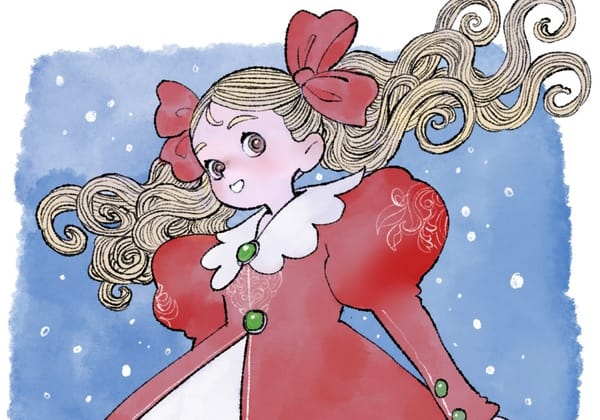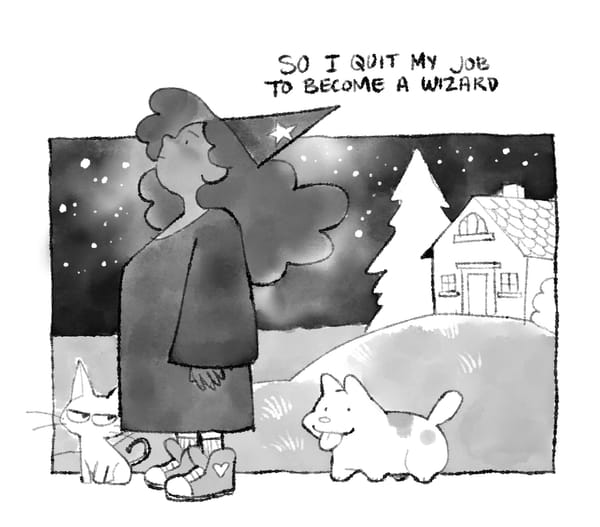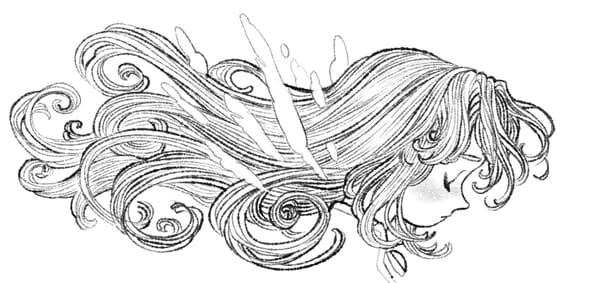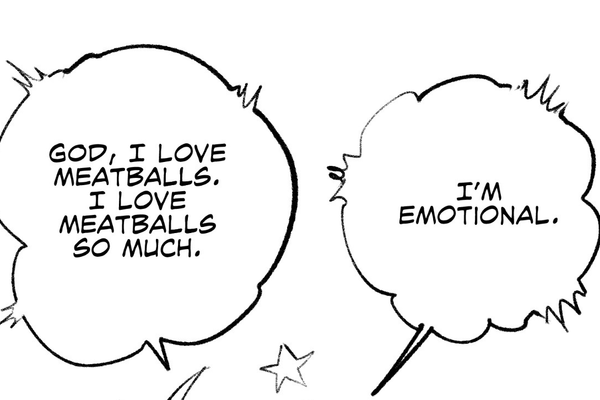Backlog: Processing Process, and More Processing
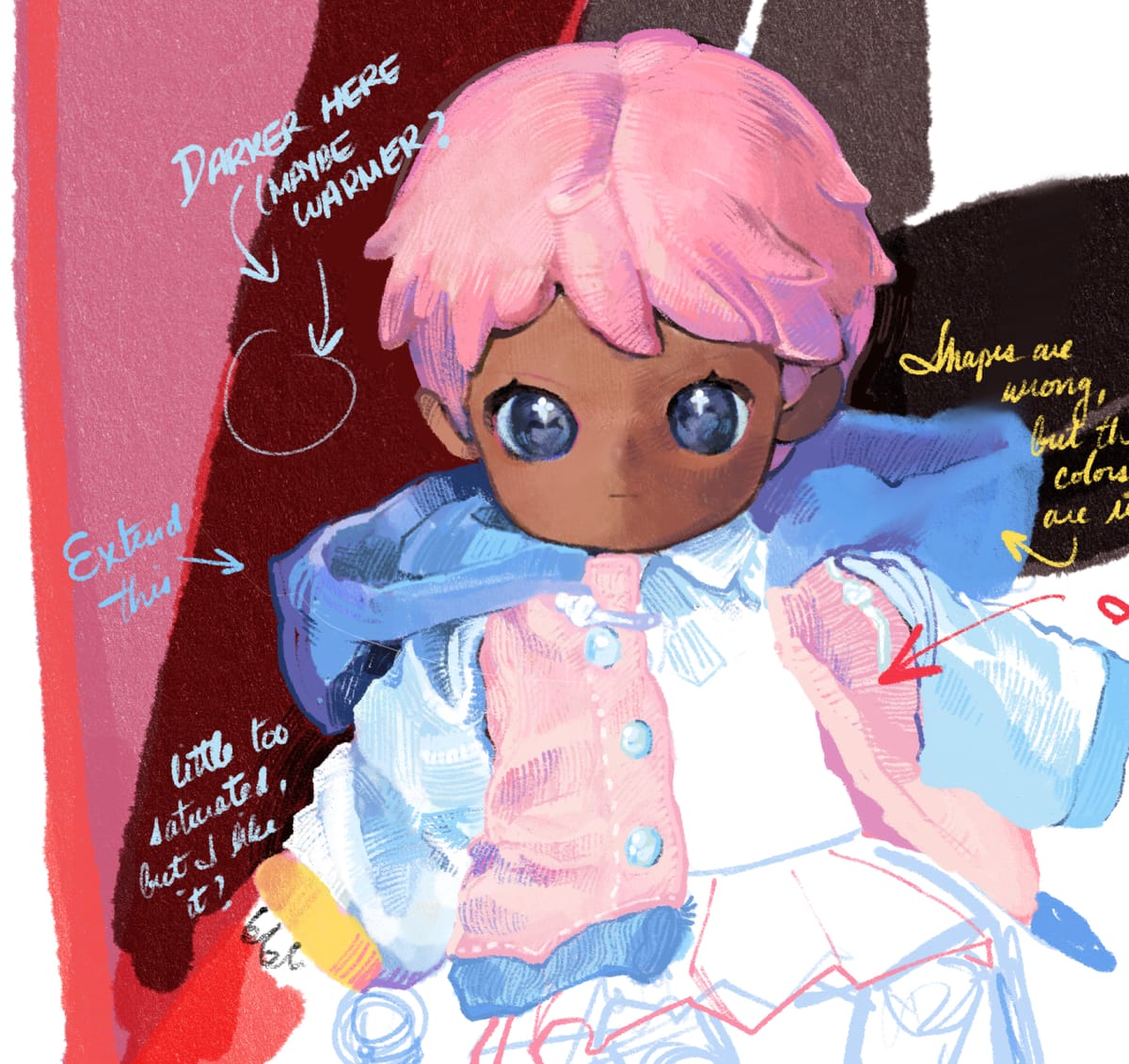
This entry was originally posted to Patreon on March 14, 2024
I wrote “process” more than once, and now the word looks funny and is beginning to lose its meaning to me.
This post is about a few things, and it’s a little bit on the sad end. Nothing dire! No worries. There’s a little mention of death, just as a heads up.
Before we get to that, though, I’ve been doing some work and had some thoughts.

I’m often asked about how I draw the noodle hair on my characters, and the answer is typically that I draw each and every line with my hand. But there are considerations of movement and volume that go into it beyond its texturally decorative purposes. I love being able to convey shape and motion with it. It’s less evident, I think, in my illustration work, but it’s much more obvious when I do sequential work. In the above image, you can see me working out a sequence of Angelica having a series of thoughts. Her head sort of moves, and her eyes follow. You can see I’d planned out the general shape of the hair and how I’d like it to move in the underdrawing.

I wound up moving the drawings a little bit so that the readers eyes will actually follow the character’s eyes as it moves gently rightward on the page with each descending panel. The hair is there to accentuate the movement, like so:

It’s a consideration I employ in all my drawings, but especially when I’m drawing hair and fabric. I don’t use a lot of action lines, so this becomes an important way to give the reader the information that someone is moving through a space. Resistance, gravity, and motion are all things I have to keep in the back of my head when I’m doing these little drawings. I think the planning actually takes more time than the inking, which can happen pretty quickly once I map it all out.
In other news, I’m starting to take my extracurricular artistic development a little more seriously in the silliest way possible.

You wouldn’t know it, but I studied painting college—a medium I switched to after the printmaking professor and head of the Art Department at the time told me I probably shouldn’t be an artist (he gave me a hard candy for my trouble). I recently bought a bunch of little dolls, dressed them up, and am returning to my painting roots. It sometimes feels really nice to work in big blobs of color instead of lines. Different part of the brain or soemthing. It’s an exercise I recommend in response to a common lament from art students.
One of the more aggravating generational tensions described to me by art school students is when professors describe a student’s portfolio as “too anime” without much explanation. I know what the professor means. They’re trying to get at how referencing your favorite anime or cartoons means that your style often becomes a flat simulacrum, an imperfect copy of a copy, and you never learn to develop your own sense of judgment about where a line or a shape needs to go. And people can tell. It’s a way of working that is perfectly fine for cartooning, generally, because cartooning is closer to hand-writing than it is to drawing. I always turn to Charles Schulz’s work for an example. Those figures aren’t literally depicting children—with their little chessboard-pawn proportions and bread-loaf feet—but we read them as endearing children because we’ve come to a consensus between us, the readers, and Charles Schulz, the author, that those shapes mean those things. There are no whiskers or paws in the shape of the word “CAT” but you look at those three letters together, and you know the thing to which it refers. That’s an aspect of cartooning, too. Of course, what elevates cartooning from mere writing is, in part, due to the fact that those little figures do not lose their meaning the more you depict them, unlike the title of this post.
To really draw well, though, you have to do those fundamentals. You have to draw from life. There’s no way around it. It helps you develop a stronger sense of where you like to lay down your lines and shapes, no matter how stylized you like to work. It grows your judgment, and every artist’s best tool is their own well-honed sense of artistic discernment about their own work.
But that doesn’t mean you have to surrender the stuff you like or the things that inspire you to make art! I tell students that if they want to hold fast to their anime style AND hone their fundamentals to develop their eye as an artist, they should buy little figurines or toys of their favorite characters, prop those up against a light source, and draw them as still life objects. Like, yes, do the vases and the figure drawings and all those, I still think those are important. But if this is what you need to keep you interested in drawing from life, having some toys around is a great way to do it! Bless those sculptors and toy designers. They’re the best. Also, toys are just fun, and people should have toys.
I think there’s something to be said about remembering to imagine the physicality of the things we draw, in all its dimensions, in the way it catches the light or casts a shadow. It helps sentimentalize things, too, and makes them feel more real, even emotionally.

Edwina died on Tuesday, after a few final snuggles, surrounded by her favorite treats. She was about five years old, which is old for a chicken, and she had a very comfortable life. We buried her this morning. She was a good hen, J’s personal favorite.

It really feels like the end of an era. She was the last surviving member of our very first flock. After the other hens died, she really seemed to prefer the company of people over hens. She is survived by Snooki and Nelly, our two other young birds who get along quite well together.
A baby chick costs between three and five American dollars, typically. An egg-laying hen could be between twenty and fifty bucks, depending on the breed. There are roughly 26 billion chickens living in the world today, and about 518 million of them here in the United States. They come pretty cheap. And a part of me was moved to cynicism, entertaining the thought that it might be strange to feel sadly over a little animal that, at most, might be roughly equivalent to the price of a fancy lunch and a coffee.
I rewatched the 1974 musical version of The Little Prince recently, and I remember it mostly because Bob Fosse was in it and scared the crap out of me as a kid—he played the snake that would take the Little Prince back into the sky when his body got too heavy to take with him. Gene Wilder plays the Fox whom the Little Prince befriends and tames among a garden of roses. The Fox explains that he is like any other fox in the world, but he is changed—made special and particular to the Little Prince—with time, effort, and patience. So, too, is the Prince’s little flower special to him among the garden of roses. Out of all the flowers in the universe, she was the one he watered and protected under a little glass jar. And that’s enough.
I knew my little hen would not live that long. It could be very easy to take a broad view of the life expectancy of a hen and distance myself from her by virtue of her mortality and commonness. People who raise livestock do it all the time. But I also think it’s wonderful that we should all be capable of loving very small, very brief little things. Edwina is not, to my mind, the rough equivalent of a fancy lunch and a coffee. She was our little hen. For her whole life, she was ours. And I’m so happy she was here.


